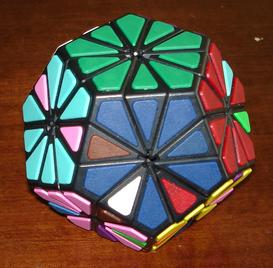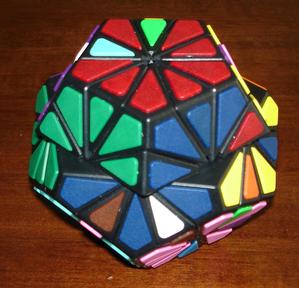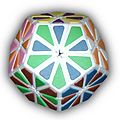Pyraminx Crystal facts for kids
The Pyraminx Crystal is a puzzle shaped like a dodecahedron, which means it has 12 sides. It's a lot like the famous Rubik's Cube and the Megaminx puzzle. A puzzle maker named Uwe Mèffert makes and sells it. You could find it in his puzzle shop starting in 2008.
This puzzle was first made in 2006. Its original name was the Brilic. Aleh Hladzilin, who was part of the Twisty Puzzles Forum, created it. Don't mix it up with the regular Pyraminx, which is a different puzzle also made by Meffert.
Contents
What is the Pyraminx Crystal?
The Pyraminx Crystal is a 12-sided puzzle. It's cut so that each slice goes through the middle of five different sides. This cuts the puzzle into many smaller parts. It has 20 corner pieces and 30 edge pieces. That's 50 pieces in total!
Each side of the puzzle has five corner pieces and five edge pieces. When you turn one side, these pieces move. Five more edge pieces also move with that turn. Each corner piece touches 3 different sides. Each edge piece touches 2 different sides. You can mix up the pieces by turning sides next to each other.
The main goal of the puzzle is simple. First, you scramble all the colors. Then, you try to get all the colors back to their correct sides.
How to Solve the Pyraminx Crystal
Solving the Pyraminx Crystal is similar to solving a Megaminx. This is because the Pyraminx Crystal is like a Megaminx but with more cuts. You can use the same steps to solve the corner pieces.
After the corners are in place, you need to solve the edge pieces. There's a simple four-move trick you can use. It's like a move from the Rubik's Cube. This move is often called R L' R' L. This special move helps you arrange the edge pieces without messing up the corners. You can do this move over and over until all the edge pieces are in their correct spots.
How Many Ways Can You Scramble It?
The Pyraminx Crystal can be scrambled in a huge number of ways! It has 30 edge pieces and 20 corner pieces. Each piece can be in different positions and orientations.
The total number of possible ways to scramble the Pyraminx Crystal is incredibly large. It's about 1.68 followed by 65 zeros! That's a number so big it's hard to imagine.
The exact number is: 1,677,826,942,558,722,452,041,933,871,894,091,752,811,468,606,850,329,477,120,000,000,000.
This huge number shows how challenging the Pyraminx Crystal can be to solve!
Images for kids




